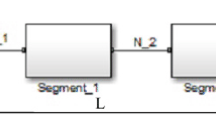Abstract
This paper investigates the transient behavior and the water hammer in pipelines due to rapid changes in the operation of the group of parallel pumps. After a brief introduction of the water hammer and the boundary conditions related to the transient characteristics of a group of pumps with a parallel arrangement, a time marching second-order finite difference scheme based on the MacCormack method is used to discretize and solve the governing equations. The excellent validity of the present model is evaluated by comparing the obtained results with another well-known solution from previous studies. For example, in case No. 1, which considers the transient behavior of a pumping station with parallel pumps, the maximum absolute difference of the energy head from the proposed model results compared with the benchmark solution is 0.79%. Besides, two other examples are considered, using the present model to investigate the water hammer caused by different scenarios of changing in the operation of the parallel pumps. The results show that the transient characteristics of the system entirely depend on the shutdown and the start-up pattern of the group of pumps. So, variations in the trip and startup times result in a significant change in the pressure increase caused by the water hammer.









Similar content being viewed by others
Availability of data and material
Available in request.
Code availability
Available in request.
References
Behroozi AM, Vaghefi M (2020) Numerical simulation of water hammer using implicit Crank-Nicolson local multiquadric based differential quadrature. Int J Press Vessel Pip 181:104078. https://doi.org/10.1016/j.ijpvp.2020.104078
Zuo Q, Qiu S, Lu W, Tian W, Su G, Xiao Z (2013) Water hammer characteristics of integral pressurized water reactor primary loop. Nucl Eng Des 261:165–173. https://doi.org/10.1016/j.nucengdes.2013.03.038
Tian W, Su GH, Wang G, Qiu S, Xiao Z (2008) Numerical simulation and optimization on valve-induced water hammer characteristics for parallel pump feedwater system. Ann Nucl Energy 35(12):2280–2287. https://doi.org/10.1016/j.anucene.2008.08.012
Afshar MH, Rohani M (2008) Water hammer simulation by implicit method of characteristic. Int J Press Vessel Pip 85(12):851–859. https://doi.org/10.1016/j.ijpvp.2008.08.006
Zhao M, Ghidaoui MS (2004) Godunov-type solutions for water hammer flows. J Hydraul Eng 130(4):341–348. https://doi.org/10.1061/(ASCE)0733-9429(2004)130:4(341)
Wahba EM (2006) Runge-Kutta time-stepping schemes with TVD central differencing for the water hammer equations. Int J Numer Methods Fluids 52(5):571–590. https://doi.org/10.1002/fld.1188
León AS, Ghidaoui MS, Schmidt AR, García MH (2008) Efficient second-order accurate shock-capturing scheme for modeling one- and two-phase water hammer flows. J Hydraul Eng 134(7):970–983. https://doi.org/10.1061/(ASCE)0733-9429(2008)134:7(970)
Chen H, Liu H, Chen J, Wu L (2013) Chebyshev super spectral viscosity method for water hammer analysis. Propuls Power Res 2(3):201–207. https://doi.org/10.1016/j.jppr.2013.07.004
Wan W, Huang W (2018) Water hammer simulation of a series pipe system using the MacCormack time marching scheme. Acta Mech 229(7):3143–3160. https://doi.org/10.1007/s00707-018-2179-2
Mahdizadeh H (2019) Numerical modelling of one- and two-dimensional water hammer problems using a modified wave propagation algorithm and turbulence model. J Hydraul Res 57(3):374–385. https://doi.org/10.1080/00221686.2018.1459897
Tsukamoto H, Ohashi H (1982) Transient characteristics of a centrifugal pump during starting period. J Fluids Eng 104(1):6–13. https://doi.org/10.1115/1.3240859
Thanapandi P, Prasad R (1995) Centrifugal pump transient characteristics and analysis using the method of characteristics. Int J Mech Sci 37(1):77–89. https://doi.org/10.1016/0020-7403(95)93054-A
Bergant A, Simpson AR, Tijsseling AS (2006) Water hammer with column separation: a historical review. J Fluids Struct 22(2):135–171. https://doi.org/10.1016/j.jfluidstructs.2005.08.008
Bergant A, Simpson AR (1999) Pipeline column separation flow regimes. J Hydraul Eng 125(8):835–848. https://doi.org/10.1061/(ASCE)0733-9429(1999)125:8(835)
Ahmadi A, Keramat A (2010) Investigation of fluid–structure interaction with various types of junction coupling. J Fluids Struct 26(7–8):1123–1141. https://doi.org/10.1016/j.jfluidstructs.2010.08.002
Feng T, Zhang D, Song P, Tian W, Li W, Su GH, Qiu S (2017) Numerical research on water hammer phenomenon of parallel pump-valve system by coupling FLUENT with RELAP5. Ann Nucl Energy 109:318–326. https://doi.org/10.1016/j.anucene.2017.05.049
Fan C, Zhang J, Yu X (2018) Analytical solutions for predicting the maximum pressure drop after pump failure in long-distance water supply project. Water Supply 18(6):1926–1936. https://doi.org/10.2166/ws.2018.014
Yang Z, Cheng Y, Xia L, Meng W, Liu K, Zhang X (2020) Evolutions of flow patterns and pressure fluctuations in a prototype pump-turbine during the runaway transient process after pump-trip. Renew Energy 152:1149–1159. https://doi.org/10.1016/j.renene.2020.01.079
Swamee PK, Jain AK (1976) Explicit equations for pipe-flow problems. J Hydraul Div 102(5):657–664. https://doi.org/10.1061/JYCEAJ.0004542
Larock BE, Jeppson RW, Watters GZ (1999) Hydraulics of pipeline systems. CRC Press, Florida
Wylie EB, Streeter VL, Suo L (1993) Fluid transients in systems, vol 1. Prentice Hall, New Jersey
Chaudhry MH (1968) Boundary conditions for analysis of waterhammer in pipe systems. Dissertation, University of British Columbia
MacCormack RW (1969) The effect of viscosity in hypervelocity impact cratering. 4th Aerodyn Test, vol 40. American Institute of Aeronautics and Astronautics, Reston, pp 757–763
Chaudhry MH, Hussaini MY (1985) Second-order accurate explicit finite-difference schemes for waterhammer analysis. J Fluids Eng 107(4):523–529. https://doi.org/10.1115/1.3242524
Fennema RJ, Chaudhry MH (1986) Explicit numerical schemes for unsteady free-surface flows with shocks. Water Resour Res 22(13):1923–1930. https://doi.org/10.1029/WR022i013p01923
Author information
Authors and Affiliations
Corresponding author
Ethics declarations
Conflict of interest
All authors have no conflict of interest to report.
Rights and permissions
About this article
Cite this article
Behroozi, A.M., Vaghefi, M. Numerical Investigation of Water Hammer due to Transient in Parallel Pumps. Int J Civ Eng 19, 1415–1425 (2021). https://doi.org/10.1007/s40999-021-00640-w
Received:
Revised:
Accepted:
Published:
Issue Date:
DOI: https://doi.org/10.1007/s40999-021-00640-w




